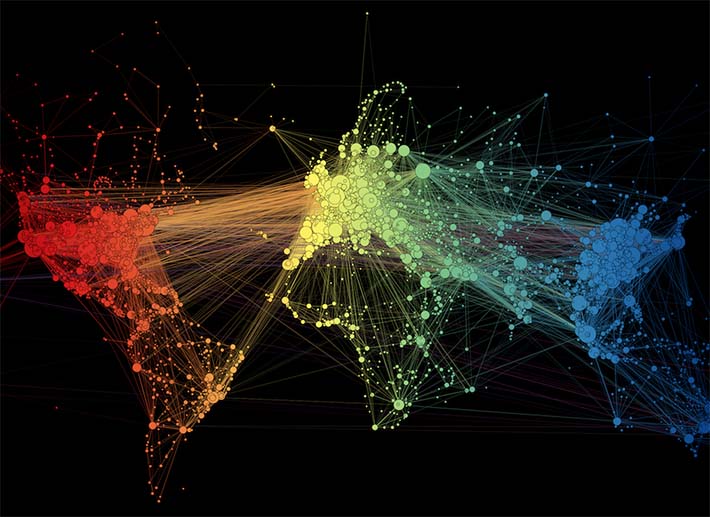The idea of the long tail of products is not new – almost everyone is familiar with the corollary 80/20 principle. Simply put, the concept of a business earning 80% of its revenue from 20% of its products (and vice-versa) applies to most verticals that we come across. Indeed, the decay curve that plots the reducing contribution of each product as one moves further down the long tail turns out to be pretty much the same shape every time. Chris Anderson, Editor in Chief of Wired even reversed the concept in his book ‘The Long Tail: Why the Future of Business Is Selling Less of More’. He cites examples as diverse as the music industry to Amazon and Google search terms.
To get a sense of how this phenomenon affects the airline industry, I chatted with two of the founders of Longtail Technologies, Adam Aly and Aditya Dakshinamoorthy. They are applying the latest in intelligent computation of big data to the long tail of airline pricing – but more of that later.
Revenue Management 101
Before we go any further, it’s probably worth a quick description of the basic workings of airline Revenue Management – the process by which airlines ensure that each seat is sold at the right price and the right time (with apologies to the real experts for the simplification!). The process starts with analyzing the airline’s competitive position on all of the routings it wishes to sell tickets on. This leads to the design and implementation of fares – these are effectively the range of prices that could be charged for that routing on a given day. Finally, the most complex activity is optimisation – deciding which prices will be made available when someone actually makes an itinerary enquiry. Thus there are two distinct stages in Revenue Management – creating fares (known as pricing) and optimizing the availability of seats to those prices (known as inventory). Simple, right?
Partner networks create long tails
The 80/20 effect is widely seen in airline networks and the routes that they decide to sell. As Aditya says, “In the world of travel the concentration of people and money (ie. cities) causes airlines to construct networks that serve the largest points. Everything else is served by complex journeys with 1,2 or more transfers.” So travelers going from London to New York have a dazzling array of direct choices yet a journey from Little Rock, Arkansas to Umeå in Sweden can expect at least two changes along the way. These routes are the long tail of every network airline.

Airlines rely on partnerships with other carriers, often within the same alliance, to cover these destinations beyond their own network. It gives them more dots on the map, and these flows are vital to fill seats that wouldn’t otherwise be filled by the core routings. Indeed IATA sees these interline relationships as key to post-pandemic recovery and lists pricing as a key component of that strategy.
Adam described an example: A small European carrier may have only 5 actual routes between Europe and the US. But their US partners connect them to 150 further destinations and of course their own European network may also offer 50 different cities. Do the math – it creates 7,500 possible routings between US and European cities. Larger airlines will have over 200,000 routings in their partner network – now that’s a long tail. And whilst the Revenue Management Inventory analysts focus on their own metal flights, their pricing colleagues need to create fares for the entire partner network.
An army of analysts?
Adam and Aditya explain that setting fares for these routings is very labor intensive. Determining prices for these small markets uses the same process as used for large trunk markets – meaning the long tail of very small routes needs a huge amount of work to cover it. So airlines understandably focus on core markets – and given limited resources that’s the right business decision. Aditya adds that “Most airlines don’t even have the computational capability to calculate how much revenue could come from their total potential network.”
Creating and filing these fares is surprisingly important – in fact it’s critical. When an airline does not file a fare for a routing then they don’t show up in any of the major retail outlets like Expedia etc. Imagine you wish to travel from Little Rock to Umeå and you ask Google, Kayak or Skyscanner to give you the options. Sometimes the most obvious airlines are not in the results – often because they didn’t have the fares filed for the search engines to find. Far from getting 20% of the long tail revenue opportunity, these airlines instead risk getting zero!
However, most airlines are aware of the long tail problem and as Adam notes, they even recognize that they will never be able to solve it properly without the input of an army of analysts. Instead they have deployed mass solutions such as adding a fixed add-on to cover each beyond point destination. These kinds of prices are only reviewed periodically, as opposed to the trunk routings where pricing is checked against competitors several times per day. So in these cases the airlines are getting some of the 20% long tail revenue, but certainly not all of it.
A better way
Aditya is quick to point out that a lot has changed in the world of technology. Huge amounts of relevant data is now readily available to drive autonomous and intelligent algorithms that can create pricing structures for the smallest of opportunity markets. Where airlines have traditionally used mostly internal sources of data (e.g. ticket sales on their own routes from previous years), now the world of data has opened up to allow feeds from external sources – global network databases, real time demand sources, retail comparisons etc. These data feeds are becoming available in malleable formats that make for better manipulation by the algorithms.

Furthermore, large scale computing power is cheaper than ever before, allowing the algorithms to process these huge data flows rapidly. A single airline pricing analysis may contain several terra-bytes of data, yet can be complete in only a few hours. Automated decision making is now even better thanks to the availability of machine learning and intelligence in computing power.
Adam believes that these new capabilities could be a way to solve the long tail dilemma at last. Pricing decision machines could now use this data to make decisions proactively that would have previously required unsustainable levels of analyst resource, monitoring an impossibly large number of competitor actions across the world and reacting to every single one. He notes that the industry collectively makes more than 1 billion pricing actions and 150,000 schedule changes every day! Moreover, the consequent dramatic increase in the granularity of segmentation allows airlines to have the right prices for the right customers at the right time, on even very small routings. This intelligent automation allows an airline to move from a ‘compete with 1 competitor’ route-strategy to a multilateral approach that encompasses the whole market.
The whole picture will get even more detailed with IATA’s New Distribution Model (NDC) which opens up the world of dynamic and continuous pricing for airlines. According to ATPCo, this will drive a substantial growth in price points – all of which need to be calculated, reviewed and updated in real time. That can only happen with intelligent automations working at hyper-speed on huge volumes of data. Adam and Aditya are sure that transitioning to that future starts with tackling the long tail as we know it today.

